ZTE Z777 WCDMA/GSM (GPRS) Dual-Mode Digital Mobile Phone User Manual San Francisco
ZTE Corporation WCDMA/GSM (GPRS) Dual-Mode Digital Mobile Phone San Francisco
ZTE >
User manual
1
Z777
USER
MANUAL
www.zteusa.com

2
Thank you for choosing this ZTE mobile device. In order to
keep your device in its best condition, please read this
manual and keep it for future reference.
Copyright
Copyright © 2014 ZTE CORPORATION
All rights reserved.
No part of this publication may be quoted, reproduced,
translated or used in any form or by any means, electronic or
mechanical, including photocopying and microfilm, without the
prior written permission of ZTE Corporation.
Notice
ZTE Corporation reserves the right to make modifications on print
errors or update specifications in this guide without prior notice.
This manual has been designed with the utmost care to ensure
the accuracy of its content. However, all statements, information
and recommendations contained therein do not constitute a
warranty of any kind, either expressed or implied. Please refer to
chapter “For Your Safety” to be sure to use your phone properly
and safely.
We offer self-service for our smart terminal device users. Please
visit the ZTE official website (at www.ztedevice.com) for more
information on self-service and supported product models.
Information on the website takes precedence.

3
Disclaimer
ZTE Corporation expressly disclaims any liability for faults and
damages caused by unauthorized modifications of the software.
Images and screenshots used in this manual may differ from the
actual product. Content in this manual may differ from the actual
product or software.
Trademarks
ZTE and the ZTE logos are trademarks of the ZTE Corporation.
Google and Android are trademarks of Google, Inc.
The Bluetooth® trademark and logos are owned by the Bluetooth
SIG, Inc. and any use of such trademarks by ZTE Corporation is
under license.
microSDHCHC logo is a trademark of SD-3C, LLC.
Other trademarks and trade names are the property of their
respective owners.
Version No.: R1.0
Edition Time: 2014.3
4
Table of Contents
Getting Started ....................................................... 11
Starting Up .................................................................. 11
Installing the micro-SIM Card and Battery .............. 11
Installing the microSDHCTM Card (Not Included) .... 13
Charging the Battery .............................................. 14
Switching Your Phone On/Off ...................................... 15
Setting Up Your Phone for the First Time ............... 15
Switching to Sleep Mode ........................................ 16
Waking Up Your Phone .......................................... 17
Getting Around ............................................................ 17
Touch Control ........................................................ 17
Getting to Know Your Phone ....................................... 18
Knowing the Keys ........................................................ 21
Home Screen ......................................................... 21
Status and Notification Icons .................................. 23
Using the Notification Panel ................................... 25
Phone Calls ............................................................ 28
Making Calls ................................................................ 28
Calling From the Dialer ........................................... 28
Calling From Your Contacts ................................... 28
Calling From a Text Message ................................. 29
Using Speed Dial ................................................... 29
Receiving Calls ............................................................ 30
Answer a Call ......................................................... 30
5
Reject a Call ........................................................... 30
Muting a Call........................................................... 30
Putting a Call on Hold ............................................. 30
Turning the Speakerphone On/Off .......................... 31
Ending a Call .......................................................... 31
Adjusting Your Call Settings ......................................... 31
People ..................................................................... 33
Importing and Exporting Contacts ................................ 33
Importing or Exporting Contacts (micro-SIM Card) .. 33
Importing or Exporting Contacts (microSDHC or
Phone Storage) ...................................................... 34
Sharing Contacts Information ....................................... 34
Creating a Contact ....................................................... 34
Adding a Contact to Favorites ...................................... 35
Searching for a Contact................................................ 35
Creating a New Group ................................................. 35
Entering Text .......................................................... 37
Change Input Methods ................................................. 37
Android Keyboard ........................................................ 37
TouchPal Keyboard...................................................... 39
Google Voice Typing .................................................... 43
Input Method Settings .................................................. 43
Messaging .............................................................. 45
Message Box ............................................................... 45
Sending a Message ..................................................... 45
6
Changing Message Settings ........................................ 46
Email ....................................................................... 49
Creating an Email Account .......................................... 49
Receiving Emails ......................................................... 49
Composing and Sending an Email ............................... 49
Replying to or Forwarding an Email ............................. 50
Deleting an Email Account ........................................... 51
Email Settings ............................................................. 51
Getting Connected to the Internet ........................ 52
Adding a New Mobile Data Connection ........................ 52
Turning On Wi-Fi ......................................................... 53
Connecting to a Wi-Fi Network .................................... 53
Adding a Wi-Fi Network ............................................... 53
Checking the Wi-Fi Network Status ............................. 54
Adding WPS Network .................................................. 54
Browsing the Internet ............................................ 55
Opening a Web Page .................................................. 56
Browsing Options ........................................................ 56
Using Bookmarks ........................................................ 57
Editing a Bookmark ................................................ 57
Deleting a Bookmark .............................................. 57
Using Multiple Browser Tabs ....................................... 58
Changing Browser Settings ......................................... 59
Using Wi-Fi Direct .................................................. 60
Connecting to Another Device via Wi-Fi Direct ............ 60
7
Sending Data via Wi-Fi Direct ...................................... 60
Receiving Data via Wi-Fi Direct .................................... 61
Bluetooth® .............................................................. 62
Using Bluetooth ............................................................ 62
Making the Most of Multimedia ............................. 64
Taking Pictures With Your Camera .............................. 64
Adjusting Camera Settings ........................................... 66
Shooting Video With Your Camcorder .......................... 67
Adjusting Your Video Settings ...................................... 68
Playing Your Music ...................................................... 68
Playing Your Videos ..................................................... 70
Opening Your Gallery ................................................... 71
Making Memorable Memos .......................................... 72
Recording a Voice Memo ........................................ 72
Playing a Voice Memo ............................................ 73
Using Your Google™ Applications ...................... 74
Gmail ........................................................................... 74
Google Calendar .......................................................... 75
Google+ ....................................................................... 75
Google Maps ............................................................... 76
Getting Your Location ............................................. 76
Searching for a Location ......................................... 77
Getting Directions to Your Destination .................... 77
Searching for Local Places ..................................... 78
Google MusicTM ............................................................ 79
8
Playing Your Music ................................................ 79
Sorting out Your Phone Settings .......................... 82
Setting Date and Time ................................................. 82
Changing Display Settings ........................................... 82
Sound Settings ............................................................ 83
Language Settings ....................................................... 83
Mobile Network Services ............................................. 83
Security Settings.......................................................... 83
Protecting Your Phone With a Screen Unlock Pattern
.............................................................................. 84
Protecting Your Phone With Encryption .................. 85
Protecting Your micro-SIM Card With a PIN ........... 86
Setting Up Credential Storage ................................ 87
Managing Your Device Memory ................................... 88
Privacy: Reset to Factory Settings ............................... 88
Managing Applications................................................. 89
How to Install an Application .................................. 89
Managing Other Settings ............................................. 90
Data Usage ............................................................ 90
Connect to PC ........................................................ 90
Accessibility ........................................................... 91
Developer Options ................................................. 91
About Phone .......................................................... 92
Other Applications ................................................. 93
Clock ........................................................................... 93
9
Set a New Alarm ..................................................... 93
Use Bed Clock ........................................................ 93
Check World Time .................................................. 94
Use the Stopwatch and Countdown ........................ 94
Calculator ..................................................................... 94
Chrome ........................................................................ 94
Downloads ................................................................... 95
File Manager ................................................................ 95
News and Weather....................................................... 95
Task Manager .............................................................. 96
YouTube ...................................................................... 96
Upgrading the Phone Software ............................ 97
Troubleshooting .................................................... 98
For Your Safety .................................................... 104
General Safety ........................................................... 104
Radio Frequency (RF) Energy .................................... 105
FCC Compliance ........................................................ 107
Hearing Aid Compatibility (HAC) regulations for Mobile
phones ....................................................................... 108
Distraction .................................................................. 110
Driving .................................................................. 110
Operating Machinery ............................................ 110
Product Handling ....................................................... 111
General Statement on Handling and Use .............. 111
Battery .................................................................. 112
10
Small Children ...................................................... 113
Demagnetization .................................................. 114
Electrostatic Discharge (ESD) .............................. 114
Antenna ............................................................... 114
Normal Use Position ............................................ 114
Air Bags ............................................................... 114
Seizures/Blackouts ............................................... 115
Repetitive Strain Injuries ...................................... 115
Emergency Calls .................................................. 115
Loud Noise ........................................................... 116
Phone Heating ..................................................... 116
Electrical Safety ......................................................... 116
Accessories .......................................................... 116
Connection to a Car ............................................. 116
Faulty and Damaged Products ............................. 117
Radio Frequency Interference ................................... 117
General Statement on Interference ...................... 117
Pacemakers ......................................................... 117
Hearing Aids ........................................................ 118
Medical Equipment ............................................... 118
Aircraft ................................................................. 118
Interference in Vehicles ........................................ 118
Explosive Environments ............................................ 119
Gas Stations and Explosive Atmospheres ............ 119
Blasting Caps and Areas ...................................... 119
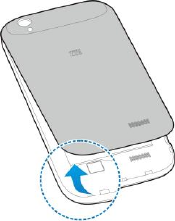
11
Getting Started
Starting Up
Installing the micro-SIM Card and Battery
Turn off your phone before installing or replacing the battery or
micro-SIM card.
1. Remove the back cover.
2. Hold the micro-SIM card with the cut corner oriented as
shown and slip it into the card holder.
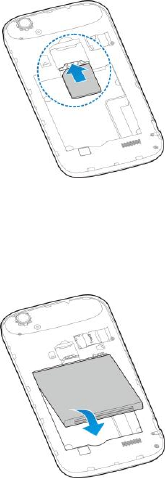
12
IMPORTANT: Your phone only supports micro-SIM card.
Please do not insert other kinds of SIM card.
3. Insert the battery by aligning the golden contacts on the
battery and those in the battery compartment. Gently
push down on the battery until it clicks into place.
4. Press the back cover gently back into place until you hear
a click.
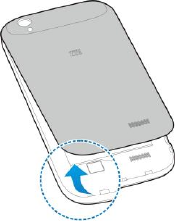
13
Installing the microSDHCTM Card (Not
Included)
The microSDHC card can be installed and removed while the
phone is turned on. Unmount the microSDHC card before
removing or replacing it.
1. Remove the back cover.
2. Insert the microSDHC card into the slot with the golden
contacts on the card facing down.
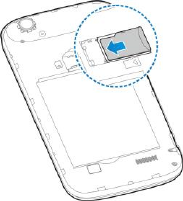
14
NOTE: Some applications may require a microSDHC card to
work normally or may store data on it. Therefore, it is
recommended that you not install, remove or replace the
microSDHC card randomly.
Charging the Battery
Although the battery comes partially charged, it is
recommended you fully charge the battery before using your
phone for the first time.
If the battery is low, there will be a pop-up message on the
screen. As you charge your phone, the screen will tell you the
exact battery level each time you wake up your phone.
WARNING! Use only ZTE-approved chargers and cables.
The use of unapproved accessories could damage your
phone or cause the battery to explode.
1. Connect the adapter to the charging jack. Ensure that the
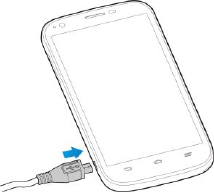
15
adapter is inserted with the correct orientation. Do not
force the connector into the charging jack.
2. Connect the charger to a standard AC wall outlet.
3. Disconnect the charger when the battery is fully charged.
Switching Your Phone On/Off
Make sure the micro-SIM card is in your phone and the
battery is charged.
Press and hold the Power Key to switch on your phone.
To switch it off, press and hold the Power Key to get the
phone options. Touch Power off, and then touch OK
Setting Up Your Phone for the First Time
When you first power on your phone after you purchase it or
reset it to factory settings (see Sorting out Your Phone

16
Settings - Privacy: Reset to Factory Settings), you need to
set up your phone settings before using it.
1. Flick the language field to select the language you want to
use and then touch Start.
2. If you’ve got a Google Account or Gmail, touch Yes to
sign in to your account. Or touch No to get an account.
You can also touch Not now to set up an account later.
3. Configure the Google location options and touch .
4. Enter your name which the phone uses to personalize
some apps and touch .
5. You will be prompted to accept the terms of Google
service. Touch to continue.
6. Touch Finish.
NOTE: If the micro-SIM card is not installed, the phone would
prompt you to connect to a Wi-Fi network before asking you
to sign in to a Google Account.
Switching to Sleep Mode
To save battery power, Sleep Mode suspends your phone to
a power-saving state while the display is off. Your phone also
goes into Sleep Mode by itself when the display is
automatically turned off after a certain period of time, which
you can set in Settings > Display > Sleep.
Press the Power Key to switch to Sleep Mode.

17
Waking Up Your Phone
1. Press the Power Key to activate your screen display.
2. Touch and hold to unlock the screen.
-or-
You can drag towards any direction to access the
application shortcuts. Touch an application or function
icon to unlock the screen and open the application or
enable the function quickly.
NOTE: If you have set an unlock pattern, a PIN or password
for your phone (see chapter Sorting out Your Phone Settings
– Security Settings – Protecting Your Phone With a Screen
Lock) you’ll need to draw the pattern, or enter the
PIN/password to unlock your screen.
Getting Around
Touch Control
Your phone’s touch screen lets you control actions through a
variety of touch gestures.
Touch
When you want to type using the onscreen keyboard,
select items onscreen such as application and settings
icons, or press onscreen buttons, simply touch them with
your finger.
18
Touch and Hold
To open the available options for an item (for example, a
message or link in a Web page), touch and hold the item.
Swipe or Slide
To swipe or slide means to quickly drag your finger
vertically or horizontally across the screen.
Drag
To drag, press and hold your finger with some pressure
before you start to move your finger. While dragging, do
not release your finger until you have reached the target
position.
Pinch
In some apps (such as Maps, Browser, and Gallery), you
can zoom in and out by placing two fingers on the screen
at once and pinching them together (to zoom out) or
spreading them apart (to zoom in).
Rotate the screen
For most screens, you can automatically change the
screen orientation from portrait to landscape by turning
the phone sideways.
Getting to Know Your Phone
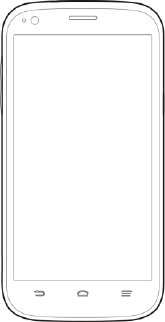
19
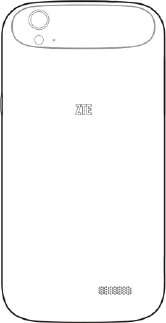
20

21
Knowing the Keys
Key
Function
Power Key
Press and hold to turn on or off Airplane
mode, enable silent mode or silent mode
with vibration, disable silent mode, power
off or restart the phone.
Press to switch your phone to Sleep
mode.
Press to wake up your phone.
Home Key
Touch to return to the home screen from
any application or screen.
Touch and hold to see recently used
applications.
Menu Key
Touch to get the options for the current
screen.
Back Key
Touch to go to the previous screen.
Volume Keys
Press or hold to turn the volume up or down.
Home Screen
You can customize your home screen. Set your own
wallpaper, add widgets or application shortcuts you need,
organize icons with folders, or remove them as you like.

22
Extended Home Screen
The home screen extends beyond the screen width, giving
you lot more space to add more stuff. Simply swipe your
finger to the left or right to see the extended home screen
panels.
Choosing Your Wallpaper
1. Touch the Home Key to return to the home screen.
2. Touch and hold a blank area of the home screen.
3. Touch Home or Lock screen.
4. Select a wallpaper source from Gallery, Live Wallpapers,
or Wallpapers and choose the image or animation you
want to use as the wallpaper. Some cropping may be
needed for Gallery images.
5. For Gallery images, adjust the area you want to use and
touch Done; for Live Wallpapers and Wallpapers, touch
Set wallpaper.
NOTE: Live Wallpapers are not available for the Lock
Screen.
Adding Items to Your Home Screen
1. Touch the Home Key > .
2. Touch Apps, Widgets or Shortcuts, depending on what
you want to add.
3. Touch and hold a widget, application icon or shortcut and
drag it to the home screen.

23
Adjusting Widget Size
1. Touch and hold a widget on the home screen and then
release it.
2. An outline appears around the widget. Drag the outline to
resize the widget.
NOTE: Not all widgets can be resized.
Organizing Icons With a Folder
1. Touch and hold the shortcut on the home screen you
want to add into a folder until appears.
2. Drag the shortcut to and release it. A new
folder will be created and the shortcut is added into the
folder.
3. To add more shortcuts into the folder, touch and hold
each shortcut and drag it over the folder before releasing
it.
TIP: Touch the folder and then touch the name field to
rename the folder.
Removing Items From Your Home Screen
1. Touch and hold a folder, a widget or a shortcut on the
home screen.
2. Drag it to to remove it.
Status and Notification Icons
Your phone will tell you exactly what’s going on by showing
you simple icons on the top status bar. Here’re some of the
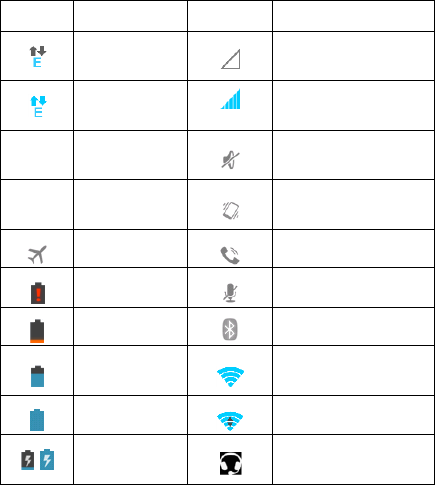
24
icons you may see.
Indicator
What it means
Indicator
What it means
EDGE data
connected
No signal
EDGE data in
use
Signal strength
WCDMA data
connected
Ringer off
WCDMA data in
use
Vibrate mode
airplane mode
Speaker on
Battery dead
Phone microphone off
Battery low
Bluetooth on
Battery partially
drained
Connected to a Wi-Fi
network
Battery full
Wi-Fi in use
/
Battery charging
Wired headset
connected
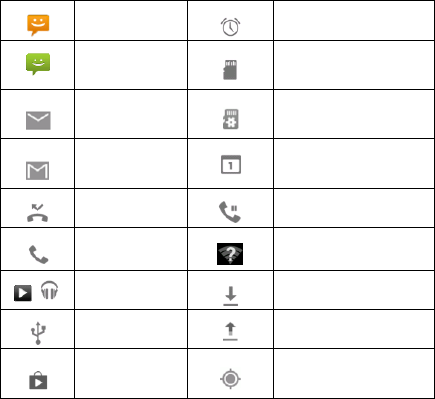
25
New SMS
Alarm set
New MMS
microSDHC card
unmounted
New Email
Preparing microSDHC
card
New Gmail
message
Upcoming event
Missed call
Call on hold
Call in progress
New Wi-Fi network
detected
/
Song is playing
Downloading data
USB connected
Sending data
Updates
available
GPS on
Using the Notification Panel
Notifications report the arrival of new messages, calendar
events, and alarms, as well as ongoing events. You can open
the notification panel to view the details of notifications.
To open the notification panel, swipe your finger down

26
from the top of the screen.
To close the notification panel, swipe your finger up from
the bottom of the screen or touch the Back Key.
Respond to or Remove a Notification
In the notification panel, you can respond to a notification or
remove the notifications. The notification panel also supports
expandable notifications that let you perform additional
actions right from the notification itself.
To respond to a notification, just touch it.
Slide down with one finger to expand certain notifications.
You can also swipe two fingers vertically or pinch-zoom to
expand or collapse certain notifications.
To remove a notification, swipe it left or right.
To remove all notifications, touch in the top right
corner.
Touch and hold a notification and then touch App info to
identify the application that created it. To turn off
notifications from that application if needed, uncheck
Show notifications in the App info screen.
Most apps that send notifications, such as Gmail and
Google+, have notification settings that you can adjust.
NOTE: If you turn off notifications for an app, you may miss
its important alerts and updates. The notifications of some
apps cannot be turned off.

27
TIP: In the notification panel, touch at the top of
notifications list to get to the Settings menu quickly.

28
Phone Calls
Making Calls
There are many ways to make a call with your phone. And
they’re all easy to do.
Calling From the Dialer
1. Touch the Home Key > .
2. In the Phone tab, enter the phone number with the
on-screen keypad. Touch to delete incorrect digits.
3. Touch below the keypad to dial.
TIP: To make an international call, touch and hold the 0 key
to enter the plus (+) symbol. Next, enter the country code,
followed by the city/area code and then the phone number.
Calling From Your Contacts
1. Touch the Home Key > > People.
2. Flick the screen up or down and touch the contact you
want to call.
TIP: You can search for a contact by touching at the
bottom of the screen.
3. Touch below the number you want to call.

29
Calling From a Text Message
If a text message contains a phone number that you want to
call, you can make the call while viewing the text message.
1. Touch the Home Key > > Messaging or touch
on the home screen.
2. Touch the conversation and find the message that
contains the phone number you need.
3. Touch the number in the message text. Options for that
number appear.
4. Touch Call.
Using Speed Dial
Touch and hold 1 ~ 9 key from the dialer to call the
corresponding speed dial number.
The number key 1 is reserved for your voicemail.
Assigning a speed dial key:
1. Touch the Home Key > > Phone.
2. In the Phone or Call log tab, touch the Menu Key >
Settings > Speed dial.
3. Touch a speed dial key.
4. Enter a phone number to select one from the contact list.
5. Touch OK.

30
Receiving Calls
Answer a Call
When you receive a phone call, drag over to
answer the call.
NOTE: To silence the ringer before answering the call, press
the Volume Keys up or down.
Reject a Call
When you receive a phone call, drag over to reject
the call.
You can also drag over to reject the call and select
a preset text message or edit one to send to the caller.
TIP: To edit the preset text response from within the Phone
app, touch the Menu Key > Settings > Quick responses.
Muting a Call
During a call, you can mute your microphone so that the
person you are speaking to cannot hear you, but you can still
hear them:
Touch Mute to turn your microphone off. To turn your
microphone back on, touch Mute again.
Putting a Call on Hold
During a call, you can put it on hold by touching Hold.

31
TIP: If you accept an incoming call while you’re on another
call, the first call automatically goes on hold. Touch Swap to
switch between the two callers.
Turning the Speakerphone On/Off
Touch Speaker during a call to turn the speakerphone on.
Touch Speaker again to turn off the speakerphone.
Ending a Call
Touch to finish a call.
Adjusting Your Call Settings
From the Phone app, you can open the call settings menu by
touching the Menu Key > Settings.
Fixed dialing
numbers
Restrict outgoing calls to a fixed set of numbers.
To do this you must know your micro-SIM card’s
PIN2 code.
Quick responses
Edit the text message that you can send to the
caller while rejecting his/her call.
Voicemail
Service
Select voicemail service provider.
Setup
Edit the voicemail number.
Ringtone
Set the notification sound for new
voicemails.
Vibrate
Set the condition for vibration.

32
TTY mode
Set up TTY mode for users with hearing or
speech difficulties.
Hearing aids
Turn on or off hearing aid compatibility.
DTMF tones
Set the length of dual-tone multi-frequency
(DTMF) signal tones.
Speed dial
Set speed dialing keys and numbers.
Call Barring
Settings
Forbid certain types of calls.
Call forwarding
Forward your incoming calls to a different
number. And choose when to forward: Always
forward; Forward when busy; Forward when
unanswered, or Forward when unreachable.
Additional settings
Caller ID
Choose whether people you call can
see your number.
Call waiting
See new incoming calls while you’re
on another call.

33
People
You can add contacts on your phone and synchronize them with
the contacts in your Google Account or other accounts that
support contact syncing.
To see your contacts, touch the Home Key > > People.
From there, you can touch the tabs on the top to quickly
switch to phone dialer, your call log, or favorites contacts.
Importing and Exporting Contacts
You can import or export contacts from/to your micro-SIM
card, the phone storage, or the microSDHC card. This is
especially useful when you need to transfer contacts
between different devices.
Importing or Exporting Contacts (micro-SIM
Card)
1. From the Contacts screen, touch the Menu Key >
Import/export.
2. Choose to import or export contacts. Your phone will
automatically display the contacts.
3. Touch the contacts you want to import or export. Or, just
touch All at the top right of the screen to select all
contacts.
4. Touch Import or Export.

34
Importing or Exporting Contacts (microSDHC
or Phone Storage)
1. From the Contacts screen, touch the Menu Key >
Import/export.
2. Choose to import or export contacts.
For import, you should have vCard files saved in the
microSDHC card or the phone storage. If there’s more
than one vCard file, you need to select the vCard file
and touch OK.
For export, the phone will prompt you with the name of
the vCard file. Touch OK to create the file.
Sharing Contacts Information
1. Touch the Menu Key > Multi-Select from the Contacts
screen.
2. Touch the contacts you want to share to select them and
then touch .
3. Choose how to share the contacts. Options depend on
the applications and services installed.
Creating a Contact
1. From the Contacts Screen, touch .
2. Touch the account field near the top of the screen to
choose where to save the contact. If a sync account is

35
selected, the contact can be synced automatically with
your account online.
3. Enter the contact name, phone numbers, email
addresses, and other information.
4. Touch Done to save the contact.
Adding a Contact to Favorites
You can add the contacts used frequently to Favorites, so
you can find them quickly.
1. From the Contacts screen, touch the contact you want to
add to Favorites.
2. Touch next to the contact’s name.
Searching for a Contact
1. Touch at the bottom of the Contacts screen.
2. Enter the contact name you want to search for.
The contacts matched will be listed.
Creating a New Group
1. Touch at the bottom of the Contacts screen.
2. Touch at the bottom of the screen.
3. Touch the account field near the top of the screen to
choose where to save the group. If a sync account is

36
selected, the group can be synced automatically with your
account online.
4. Enter the group name and touch Done.
5. Touch and select the contacts you wish to be the
group members.
6. Touch .
To send messages to the group members, you can touch a
group and then touch the Menu Key > Send group
message.

37
Entering Text
When you touch a field that needs text or numbers, a
keyboard automatically appears on the screen. Open the
notification panel and touch Choose input method to
change input method.
You can enter text using the onscreen keyboard. Some apps
open it automatically. In others, you open it by touching
where you want to type. You can also enter text by speaking
with the Google voice typing feature. Touch the Back Key to
hide the onscreen keyboard.
Change Input Methods
1. When you use the onscreen keyboard to enter text, the
icon appears on the notification bar.
2. Open the notification panel and touch Choose input
method.
3. Select an input method you need.
Android Keyboard
The Android Keyboard provides a layout similar to a desktop
computer keyboard. Turn the phone sideways and the
keyboard will change from portrait to landscape. The
landscape keyboard is not supported in all applications.
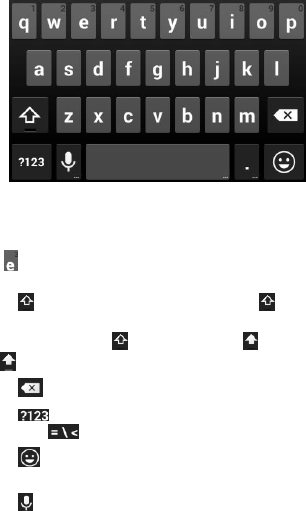
38
Touch the alphabetic keys to enter letters. Touch and
hold some specific keys to enter associated accented
letters or numbers. For example, to enter è, touch and
hold and the available accented letters and number 3
appear. Then slide to choose è.
Touch to use uppercase. Double-tap to lock
uppercase. This key also changes to indicate the current
case you are using: for lowercase, for uppercase,
and when locked in uppercase.
Touch to delete the text before the cursor.
Touch to select numbers and symbols. You can
then touch to find more.
Touch to enter miniature icons, such as expressions,
horoscopes, and animals.
Touch to use Google’s networked voice input.
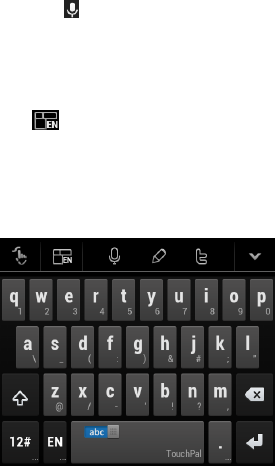
39
Touch and hold to change the input languages or set
up the Android keyboard.
TouchPal Keyboard
TouchPal Keyboard offers three layouts: T26, T12 and T+.
You can touch to select a layout or an input language.
You can also use TouchPal CurveTM to speed up text input by
replacing the key tapping operation with a tracing gesture
where you move your finger from letter to letter without lifting
the finger until you reach the end of the word.
The T26 Layout
The T26 layout offers an input experience similar to a
computer keyboard.
The alphabetic keys: Touch the keys to enter letters.
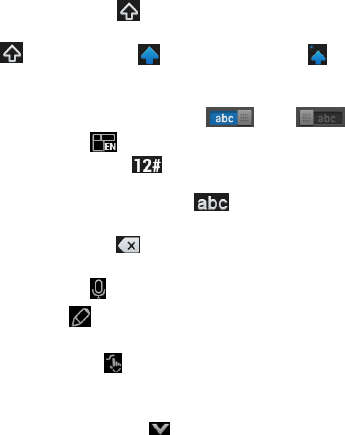
40
Touch a key and slide down to enter the number or symbol
on the key. You can also touch and hold a key and slide to
choose more characters.
The capital key: Touch to use uppercase or lowercase.
This key also changes to indicate the current case you are
using: for lowercase, for uppercase, and
when locked in uppercase.
Word prediction: Slide left or right on the space key to turn
on or off prediction, as indicated by and .
Languages: Touch to select input language.
Pre-defined texts: Touch to enter digits, symbols,
emoticons and other pre-defined texts. You can touch 1/3,
2/3, or 3/3 to turn pages, or touch to go back to the
alphabetic keys.
The delete key: Touch to delete text before the cursor.
You can also slide left on the key to delete a entire word.
Voice input: Touch and speak through the microphone.
Edit text: Touch to open text editing options. You can
move the cursor, select, cut, copy, paste, or delete text.
More options: Touch to access the quick settings of
TouchPal keyboard, change keyboard skin, or check
messages from TouchPal.
Close the keyboard: Touch . You can touch the text
field again to show the keyboard.
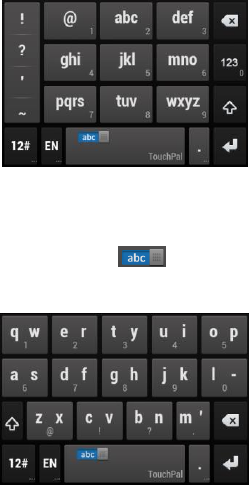
41
The T12 Layout
The layout is similar to a phone pad in T12 mode.
Touch an alphabetic key repeatedly until the desired letter
appears. You can also touch and hold the key and slide left
or right to choose the letter or number you need.
If word prediction is enabled ( ), just touch the keys
once and choose the right word.
The T+ Layout
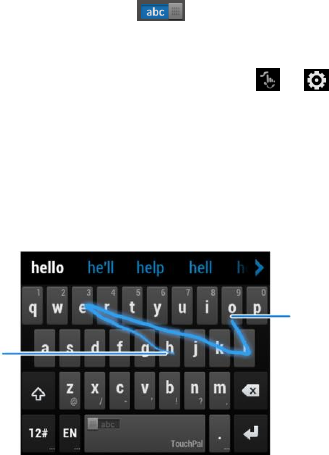
42
Touch to enter the left letter on the key; Double-tap or flick
right to enter the right letter/symbol on the key. You can also
touch and hold a key and slide left or right to choose more
letters and symbols.
If word prediction is enabled ( ), just touch the keys and
choose the right word.
To enable and use TouchPal Curve:
1. In the TouchPal keyboard screen, touch >
and check TouchPal Curve®.
2. If prompted, touch OK to switch to the T26 layout.
3. Move your finger from letter to letter on the keyboard to
trace a word without lifting the finger until you reach the
end of the word.
NOTE: TouchPal Curve is only available in the T26 layout.
End of the
word
Start of the
word

43
Tips for using TouchPal Curve:
Touch when you want to. If you want to enter a single letter,
go ahead and touch.
Lift your finger at the end of the word. A space is added
automatically when you begin to trace the next word.
Google Voice Typing
Google Voice typing uses the Google voice recognition
service to convert speech to text. You must have a data
connection on a mobile or Wi-Fi network to use it.
1. Flick down the status bar when entering text and touch
Choose input method, and then select Google voice
typing.
Or touch to access the voice typing feature when you are
using the Android Keyboard.
2. When you see the microphone image, speak what you want
to type.
3. You can continue entering text to keep it or to delete it.
TIP: Say "comma," "period," "question mark," "exclamation
mark," or "exclamation point" to enter punctuation.
Input Method Settings
Choose input method settings by touching the Menu Key >
System settings > Language & input from the home
screen.
44
In the KEYBOARD & INPUT METHODS section, you can set
the default input method and choose the settings for input
methods.

45
Messaging
Your SMS (text message) and MMS (multimedia messaging
service) are combined and accessible in the Messaging
application. Open it by touching the Home Key > > .
Message Box
Instead of an inbox and outbox, your phone organizes all
messages you sent and received into one box, where
messages exchanged with the same number are grouped
into one message thread in the Messaging screen. You can
touch a thread to see the conversation you have had with
someone.
Message threads are sorted in chronological order with the
latest one on top.
Sending a Message
1. Touch the Home Key > > .
2. Touch Compose.
3. Add recipients by one of the following ways.
Touch the To field and manually enter the recipient’s
number or the contact name. If the phone presents a few
suggestions, touch the one you want to add.
Select recipients from your contacts by touching .

46
4. Touch Type message and type your message.
Touch the Menu Key to insert Quick Text, signature,
smiley, or contact.
If you are sending an MMS, touch to attach a file.
5. Touch Send to send your message.
NOTE: Add an attachment to text message and it will be
converted into an MMS automatically. Likewise if you remove
all attachments and the subject from an MMS, it’ll
automatically become a text message.
Changing Message Settings
The phone’s message settings are pre-configured for you to
use immediately. To change them, touch the Menu Key >
Settings from the Messaging screen.
Storage settings:
Delete old messages: Delete old messages as limits are
reached.
Text message limit: Set the maximum number of text
messages allowed in a single thread.
Multimedia message limit: Set the maximum number of
multimedia messages allowed in a single thread.
Text message (SMS) settings:
Manage SIM card messages: Manage the messages
saved in your micro-SIM card.
47
Service Center: Enables you to view and edit the service
center number.
Multimedia message (MMS) settings:
Auto-retrieve: Automatically download MMS.
MMS creation mode: Select to create an MMS message
with or without restriction, or receive warning when
adding restricted attachment to an MMS message.
Display settings:
Dialog patterns: Select dialog pattern.
Notification settings:
Notifications: Show message notifications in the status
bar.
Select ringtone: Choose a ringtone for your incoming
messages.
Vibrate: Make your phone vibrate when a new message
arrives.
Signature settings:
Add signature: Add the signature to all outgoing
messages.
Edit signature: Edit your signature, which can be added
automatically to outgoing messages.
Wap push switch settings:
Enable wap push receiving: Allow your phone to
receive wap push.
48
Emergency alerts settings:
Receive emergency alerts: Choose the types of
emergency alerts you need to receive.
Notification for unread alerts: Make your phone remind
every 10 minutes for unread alerts.
Alerts notification preview: Preview the alert tone and
vibration cadence.

49
Email
Touch the Home Key > > Email. You can enter the Email
screen to setup your email account and exchange emails.
Creating an Email Account
1. When you open Email for the first time, enter your email
address and password.
2. Touch Next to let the phone retrieve the network
parameters automatically.
NOTE: You can also enter these details manually by
touching Manual setup or when automatic setup fails.
3. Follow the on-screen instructions to finish the setup.
Your phone will show the inbox of the email account and start
to download email messages.
TIP: To add more email accounts, open Email to get the
Inbox screen. Then touch the Menu Key > Settings, and
then touch ADD ACCOUNT at the top right of the screen.
Receiving Emails
Touch in any of the email account’s boxes to download
recent emails.
Composing and Sending an Email
After creating an Email account, you can compose and send

50
email messages.
1. Touch from the Inbox screen.
2. Touch To field and enter the recipient’s address or touch
to select your contact or group.
When you enter the address, matching contacts on the
phone will be displayed. Separate each recipient with a
comma.
TIP: You can also touch the Menu Key > Add cc/bcc to
add more recipients.
3. Enter the subject and the content of your email. If
necessary, change the email priority.
4. Touch the Menu Key > Attach file to add files to the
email.
5. Touch Send at the top right of the screen to send the
message.
Replying to or Forwarding an Email
1. Open the email you want to reply to or forward from the
Inbox screen.
2. Touch or to reply to or forward the email.
You can also touch to reply to all recipients of the
email.
3. Enter the contents/recipients of your email.
4. Touch Send.
51
Deleting an Email Account
1. Open the Email application. In the Inbox screen, touch the
Menu Key > Settings.
2. Touch the account you want to delete and then touch
Remove account.
3. Touch OK to confirm. All email messages in the account
will be deleted.
Email Settings
General settings apply to all email accounts you add.
1. Open Email to get the Inbox screen.
2. Touch the Menu Key > Settings > General.
3. Make the changes you want and touch the Back Key
when you’re finished.
52
Getting Connected to the Internet
Your phone’s impressive networking capabilities allow you to
access the Internet or your corporate network with ease.
You can use default connection settings to connect to the
web via your mobile network or Wi-Fi.
The mobile data connection can be enabled/disabled
manually. Touch the Home Key > Menu Key > System
settings > Mobile networks and check or uncheck Data
enabled.
Adding a New Mobile Data Connection
To get connected via mobile network, you need a data plan
with your service provider. Also if the mobile data settings are
not pre-configured on your phone, please contact your
provider to get the necessary information.
1. Touch the Home Key > Menu Key > System settings >
Mobile networks > Access Point Names.
2. Touch the Menu Key > New APN.
3. Touch each item to enter the information you get from
your service provider.
4. Touch Save to complete.
TIP: To set the APN to default settings, touch the Menu
Key > Reset to default.

53
Turning On Wi-Fi
Wi-Fi is a wireless networking technology that can provide
Internet access at distances of up to 100 meters, depending
on the Wi-Fi router and your surroundings.
1. Touch the Home Key > Menu Key > System settings.
2. Slide the Wi-Fi switch to the ON position to turn on Wi-Fi.
Connecting to a Wi-Fi Network
1. Touch the Home Key > Menu Key > System settings >
Wi-Fi.
The Wi-Fi access points, or “hotspots”, that your phone
has detected are displayed with their names and security
settings.
2. Touch an access to connect to it.
If security features are implemented, you’ll need to enter
a password.
NOTE: Your phone automatically connects to previously
used Wi-Fi networks when they are in range.
TIP: To connect to a Wi-Fi router that supports WPS, touch
on the phone’s Wi-Fi menu and press the WPS button on
your router.
Adding a Wi-Fi Network
You can add a Wi-Fi network if the network does not

54
broadcast its name (SSID), or to add a Wi-Fi network when
you are out of range.
To connect to a secured network, you first need to get the
security details from the network's administrator.
1. Touch the Home Key > Menu Key > System
settings > Wi-Fi.
2. Slide the Wi-Fi switch to the ON position.
3. Touch .
4. Enter the network SSID (name). If necessary, enter
security or other network configuration details.
5. Touch Save.
Checking the Wi-Fi Network Status
You can check the Wi-Fi network by looking at the icon
in the status bar.
Or touch the access point that the phone is currently
connected to in the Wi-Fi screen. You can then check the
network status from the pop-up window.
Adding WPS Network
Wi-Fi Protected Setup (WPS) is a feature that makes it easy
to add your phone to the access points which supply WPS.
You can use one of the following methods to connect your
phone to a wireless network using WPS.

55
Method one: WPS button (Recommended)
1. Touch the Home Key > Menu Key > System
settings > Wi-Fi.
2. Slide the Wi-Fi switch to the ON position.
3. Touch .
4. Press the WPS button on the wireless router and the
access point will recognize your phone and add it to the
network.
Method two: PIN number
1. Touch the Home Key > Menu Key > System
settings > Wi-Fi.
2. Slide the Wi-Fi switch to the ON position.
3. Touch the Menu Key > WPS PIN Entry.
4. The WPS PIN number displays on the screen. Enter the
PIN number into the access point's setup page.
After entering the PIN number, your phone automatically
finds the access point and configures the connection.
NOTE: For detailed information about the WPS feature of
access point, please refer to its documentation.
Browsing the Internet
You can use your phone to get on the Internet via a mobile
data or Wi-Fi connection.
Touch the Home Key > > Browser.
56
Opening a Web Page
Touch the address bar to enter the website you want to
browse. Then touch Go on the keyboard.
Touch the Menu Key > Bookmarks. Select a bookmark
to open.
Touch the Menu Key > Bookmarks. Choose an item
from the HISTORY tab or SAVED PAGES tab.
Browsing Options
While viewing most web pages, you can do the following
operation.
Scroll: Swipe the screen in any direction.
Zoom out: Touch the screen with two fingers and pinch
them together.
Zoom in: Touch the screen with two fingers and spread
them apart.
Go back: Touch the Back Key to return to the page
you’ve viewed previously in the same window.
Go forward: Touch the Menu Key > Forward.
Refresh the page: Touch the Menu Key > Refresh.
Find text on the page: Touch the Menu Key > Find on
page and type the terms you want to search for.
Send the page URL to friends: Touch the Menu Key >

57
Share page and select how you want to send the URL.
Follow a link: Touch a link on the web page to open it.
Save the page for offline reading: Touch the Menu Key >
Save for offline reading. You can touch the Menu Key >
Bookmarks > SAVED PAGES to read them.
Using Bookmarks
To bookmark a web page, open it and touch or the Menu
Key, and then touch Save to bookmarks. Give the bookmark
a name (Label) and touch OK.
Editing a Bookmark
1. Open the Browser window.
2. Touch the Menu Key > Bookmarks.
3. Select an item you want to edit and hold on it until the
shortcut menu pops up.
4. Touch Edit bookmark.
5. Edit the name (Label) or save location (Add to and
Account), and then touch OK to save it.
Deleting a Bookmark
1. Open the Browser window.
2. Touch the Menu Key > Bookmarks.
3. Select an item you want to delete and hold on it until the
shortcut menu pops up.

58
4. Touch Delete bookmark and touch OK to confirm.
Using Multiple Browser Tabs
You can open several web pages at the same time (one
page in each tab) and switch between them freely.
To open a new browser tab:
1. Touch the tabs icon beside the address bar. The number
in the icon indicates the number of currently active browser
windows.
TIP: You can scroll to the top of the screen to view the address
bar.
2. Touch . A new browser window opens and the homepage
is loaded.
To switch between tabs:
1. Touch the tabs icon beside the address bar.
2. Swipe vertically to scroll through the list of opened tabs.
3. Touch the thumbnail of the tab you want to open.
TIP: Swipe a thumbnail horizontally or touch its X to close the tab.
Touch X on the top right of the screen to close all tabs.
To use incognito tab for privacy browsing:
Pages you view in incognito tabs won’t appear in your browsing
history or search history. No trace will be left on your phone once
you close the tab.
1. Touch the tabs icon beside the address bar.
59
2. Touch the Menu Key > New incognito tab.
Changing Browser Settings
Touch the Menu Key > Settings from a browser window to
change browser settings.
60
Using Wi-Fi Direct
Wi-Fi Direct allows Wi-Fi devices to connect to each other
without the need for wireless access points (hotspots).
Connecting to Another Device via Wi-Fi
Direct
1. Touch the Home Key > Menu Key > System settings >
Wi-Fi.
2. If Wi-Fi is off, slide the Wi-Fi switch to the ON position.
3. Touch the Menu Key > Wi-Fi Direct. Your phone will
search for other devices enabled with Wi-Fi direct
connections.
4. Touch a device name under PEER DEVICES to connect
with it.
The other device will receive a Wi-Fi Direct connection
prompt and need to accept the request for connection.
Both devices may need to enter a common PIN.
5. Once connected the device is displayed as “Connected”.
Sending Data via Wi-Fi Direct
1. Open the appropriate application and select the file or
item you want to share.
2. Select the option for sharing via Wi-Fi Direct. The method
61
may vary by application and data type.
3. Touch a device the phone has connected with or wait for
it to search for new devices and touch one of them.
Receiving Data via Wi-Fi Direct
When an attempt to transfer data via Wi-Fi Direct is received,
you can see a notification in the status bar. Touch Accept to
start receiving the data.
Received files are stored automatically in a dedicated folder
(WiFiShare, for instance). You can access them with the File
Manager app.

62
Bluetooth®
Bluetooth® is a short-range wireless communication
technology. Phones or other devices with Bluetooth
capabilities can exchange information wirelessly within a
distance of about 32 feet (10 meters). The Bluetooth devices
must be paired before the communication is performed.
Using Bluetooth
1. Touch the Home Key > Menu Key > System settings
and slide the Bluetooth switch to the ON position to turn
on Bluetooth. When Bluetooth is on, the icon will
appear in the status bar.
2. Touch Bluetooth. Your phone will search and display all
visible Bluetooth devices in range. You can also touch
SEARCH FOR DEVICES to search again.
NOTE: Touch your device name on the top of the screen
to make your phone visible or invisible.
3. Touch the device you want to pair with.
4. Confirm that the Bluetooth passkeys are the same
between the two devices and touch Pair. Alternately,
enter a Bluetooth passkey and touch Pair.
Pairing is successfully completed when the other device
accepts the connection or the same passkey is entered.
NOTE: The Bluetooth passkey may be fixed for certain
devices, such as headsets and handsfree car kit. You can try
63
entering 0000 or 1234 (the most common passkeys), or refer
to the documents for that device.
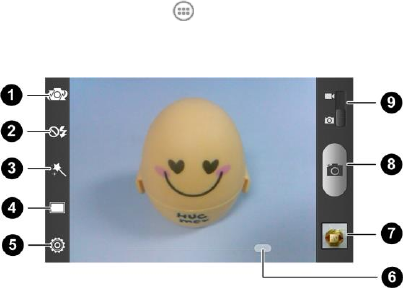
64
Making the Most of Multimedia
You can use your phone to take photos and record videos.
Photos and videos are stored to the phone’s memory card or
the phone’s internal storage. You can copy them to your
computer or access them in the Gallery app.
Taking Pictures With Your Camera
1. Touch the Home Key > > Camera.
2. Aim the camera at the subject and make any necessary
adjustment.

65
Number
Function
1
Switch between the front and the back camera.
2
Change the flash mode (only available for the
back camera).
3
Select color effect (only available for the back
camera).
4
Select normal, panorama or timing mode (only
available for the back camera).
5
Change the camera settings.
6
Slide to zoom in or out.
7
View photos and videos you have taken.
8
Capture a photo.
9
Switch between the camera and camcorder.
3. You can either let the camera autofocus on the center of the
screen, or you can touch another area on the screen that you
want to focus on.
4. Touch the shutter icon to take the photo.
WARNING! Keep a safe distance when using the flash. Do not
point the flash toward people or animals’ eyes.

66
Adjusting Camera Settings
Before taking a photo, you can touch to open the
following camera setting options.
Grid: Show or hide the composition line.
Shutter tone: Change the shutter tone.
Picture size: Set the image size for your photo.
Timer: Set a time delay before the camera takes a picture
automatically after you touch the shutter icon, or turn off
this feature.
Picture Quality: Adjust the image quality for your photo.
Image: Adjust image exposure, brightness, contrast,
saturation and sharpness.
White balance: Change white balance scenario or leave
it at Auto.
ISO: Select ISO level or leave it at Auto.
Review time: Set the auto-review time for the taken
picture. You can turn off the feature.
Geo-tag: Select whether to store the GPS location in your
captured photos.
Anti-band: Set the anti-banding value or leave it at Auto.
This feature can avoid stripes on pictures you take of TV
or computer screens.
Restore defaults: Restore default camera settings.
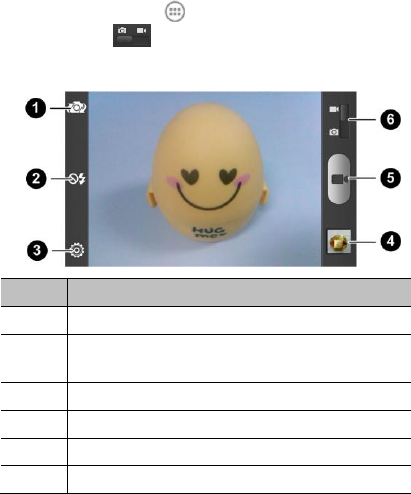
67
Shooting Video With Your Camcorder
1. Touch the Home Key > > Camera.
2. Slide the switch to open the camcorder.
3. Aim the camera at the subject and make any necessary
adjustment.
Number
Function
1
Switch between the front and the back camera.
2
Turn on or off the flash (only available for the
back camera).
3
Change the camcorder settings.
4
View photos and videos you have taken.
5
Record a video.
6
Switch between the camera and camcorder.

68
4. Touch to start recording.
5. Touch to stop recording.
TIP: While the recording is in progress, you can touch to
save the frame as a separate photo.
Adjusting Your Video Settings
Before recording a video, you can touch to open the
following camcorder setting options.
Video quality: Set the quality for your video.
Time lapse: Set the time interval between each frame
when you shot time lapse videos.
White balance: Change white balance scenario or leave
it at Auto.
Geo-tag: Select whether to store the GPS location in your
recorded videos.
Restore defaults: Restore default camera settings.
Playing Your Music
You can play the audio files stored in your phone’s
microSDHC card or internal storage in Music.
1. Touch the Home Key > > Music to access Music.
2. Select Albums, Artists, Songs, Playlists, Folders, or
GenreList to find the songs you want to play.
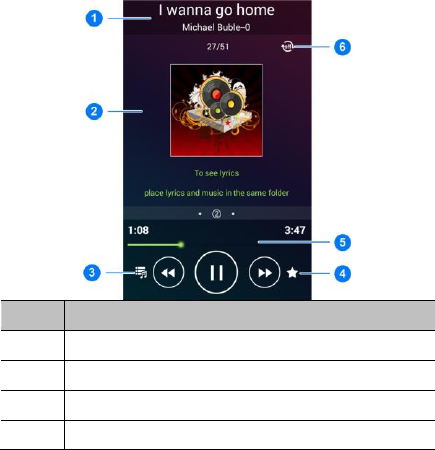
69
3. Touch an item from the list to start playing.
Number
Function
1
Song, album, and artist information.
2
Album artwork and lyrics (if available).
3
Touch to return to the music library.
4
Add the song to your favorites.
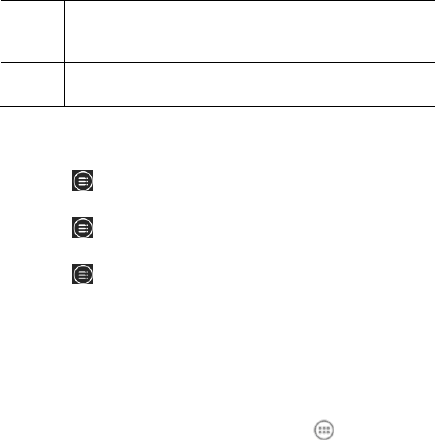
70
5
Playback control. Skip songs or pause and resume
playback. Drag the slider to jump to any part of the
song.
6
Touch to shuffle the songs in the playlist or toggle
repeat modes.
Create playlists to organize your music files into sets of
songs, so that you can play the songs you like in the order
you prefer.
Touch > Add to playlist next to a song to add it to a
playlist or create a new playlist.
Touch > Delete Playlist next to a playlist to delete the
playlist.
Touch > Rename Playlist next to a playlist to rename
the playlist.
Touch a playlist to view its content. You can touch the Menu
Key > Multi Select to select the songs you want to remove
from the playlist.
Playing Your Videos
To play a video file, touch the Home Key > > Video
Player. This will open the video library and show the video
files on your microSDHC card and phone storage. Touch a
video file to start playing.

71
Opening Your Gallery
Touch the Home Key > > Gallery to view albums of
your pictures and videos.
Touch a picture in an album to view the picture in full screen.
When viewing a picture in full screen, the following features
are available.
Swipe horizontally to see more pictures or videos.
Pinch a picture or video to make it smaller. You'll then see
a filmstrip-style view of all your pictures and videos in a
row. Swipe left or right to scan through them all.

72
TIP: You can delete a picture or video by swiping it up
or down in the filmstrip view. If you accidentally delete
one, touch UNDO to retrieve it.
Double-tap the picture, or pinch two fingers together or
spread them apart to zoom out or in.
Touch the Menu Key to rotate or rename the picture,
check file details, or change slideshow setting.
Touch to browse the album contents in a slideshow.
Touch the Gallery icon in the upper left corner to return to
the album.
NOTE: Some options may not be available for certain albums
or pictures.
Making Memorable Memos
Sound Recorder enables you to record voice memos and
listen to them whenever you like.
Recording a Voice Memo
1. Touch the Home Key > > Sound Recorder.
2. Touch to start recording. During recording, you can
do the following:
Touch / to pause or continue the recording.
Touch to cancel the recording.
3. Touch to stop recording. The memo is automatically

73
saved.
If you don’t want to save the memo after recording it, touch
> OK to delete it.
Playing a Voice Memo
To play a memo you just recorded:
Touch at the bottom of the screen.
To play any saved memo:
1. Touch at the top right of the screen to see all
recordings.
2. Touch the title of a memo to play it.
NOTE: You can also touch next to a memo to delete,
rename, share it, check its file information, add a tag, or set it
as your phone ringtone.

74
Using Your Google™ Applications
Signing in to your Google Account lets you synchronize
Gmail, Calendar events, Contacts and other data between
your phone and the web. And if you don’t have an account,
you can easily create one.
1. From the home screen, touch the Menu Key > System
settings > Add account > Google.
2. Touch Existing to sign in to your existing account, or
New to create a new account.
3. Follow the onscreen steps to enter the information about
the account.
4. Set the backup and restore option, and touch .
Gmail
Gmail is a web-based email service that’s configured when
you sign in to your Google Account. Depending on your
synchronization settings, the Gmail on your phone can be
automatically synchronized with your account on the web.
This is how you create and send a Gmail:
1. Open Gmail by touching the Home Key > > Gmail.
2. Touch .
3. Enter a contact name or email address in the ‘To’ field.
Separate each recipient with a comma.
4. Enter the email subject and compose the email text.

75
5. To attach an image or a video, touch the Menu Key >
Attach picture / Attach video.
6. Touch at the top right of the screen to send the
message.
Google Calendar
Touch the Home Key > > Calendar to use Google
Calendar, Google’s time management application. You can
use the calendar to schedule appointments, including
meetings and other events. Your appointments will be
displayed on the screen as are scheduled. You can also
synchronize appointments to your Google Account, which
enables you to manage your schedule online on your PC.
Google+
Google+ is a social networking service offered by Google.
The Google+ application on your phone enables you to
manage your data, chat with online contacts, organize them
in different circles, and share your selected information.
Touch in the Home Screen and select Google+. The
first time you open the Google+ app, select the photo & video
backup and contact sync options.
Open the Google+ app and touch at the top left to use
the following features:
Home: See posts people have shared with you, a circle you

76
are in, or everyone.
People: Find people to add to your Google+ circles, create
new circles, view and organize people into circles based on
your relationships. You can also follow content posted by
people you find interesting.
Photos: View photos you uploaded, photos of you, photos
from your posts and more.
Communities: Search and join all kinds of online
communities, where people gather for the sharing and
discussion of a common topic.
Locations: See your friends locations on the map and
configure your location sharing settings.
Hangouts: Chat with your Google+ contacts through text
messages or video call.
Events: Manage your social calendar. You can add events,
invite people, and then share photos in real time from the
event.
Search: Search for content posted on Google+.
Touch the headshot image next to your account name to view
and edit your basic information, view your posts and photos.
Google Maps
Getting Your Location
1. Touch the Home Key > > Maps.
2. Touch at the bottom.

77
The map centers on a dot and an arrow that indicate your
location and the direction the phone is facing.
Searching for a Location
1. Touch the Home Key > > Maps.
2. Touch the search box on the top and enter the place
you’re looking for in the search box at the top. You can
enter an address, a city, or a type of business or
establishment, for example, “museums in Shanghai.” As
you enter information, suggestions from your previous
searches and from popular searches appear in a list
below the search box. You can touch a suggestion to
search for it.
TIP: You can also touch beside the search box to
use voice search.
3. Touch the search key on the keyboard. Red points
indicating search results appear on the map.
4. Swipe the search result at the bottom left or right to see
other results. You can slide the result up to find more
information about the location as well as options for
getting directions and more.
Getting Directions to Your Destination
Maps can provide directions for travel by foot, public
transportation, or car.
1. Touch the Home Key > > Maps.

78
2. Touch beside the search box.
3. Select the mode of transportation and then enter a start
and end point. If your location is found, it will appear in
the start point field by default.
As suggested routes appear on the map, swipe the
bottom card left or right to choose a route. Slide the
bottom card up to see the route directions in a list.
NOTE: Touch (Start) to use Google Maps Navigation
(beta) and get turn-by-turn voice directions.
Searching for Local Places
Google Maps helps you find all kinds of businesses and
establishments around you. You can rate these places and
get recommendations
1. Touch the Home Key > > Maps.
2. Navigate the map view to the area you'd like to explore.
You can explore nearby locations or pan the map to
another location.
3. Touch the search box at the top.
4. Touch the Explore card and choose one option in the
new screen. Results will appear on cards.
5. Touch a location to see it on the map or get directions.
You can also slide up the bottom card to find out more
information, such as the street address, website, and
street view, or to call that place, save it to your Google
Account, or share it with others.

79
NOTE: The "Explore" feature is not available for all areas.
Google MusicTM
The Play Music application ( ) works with Google Music,
Google’s online music store and streaming service. You can
stream via mobile data or Wi-Fi and listen to your favorite
songs that you’ve added to your online Google Music library.
You can also play audio files you’ve copied directly to your
phone from a computer.
NOTE: The availability of Google Music is dependent on your
region. If it is not available, or you don’t have a mobile data or
Wi-Fi connection, you can only play music stored on your
phone.
Playing Your Music
Touch the Home Key > > Play Music. If you are
prompted, select an account to access its online music
library.
The app searches your online library and your phone for
music and playlists before displaying your combined music
library, organized by ARTISTS, ALBUMS, SONGS and
GENRES. You can touch > My Library / Playlists to
view all the music and playlists. To changes views of your
library, swipe left or right.
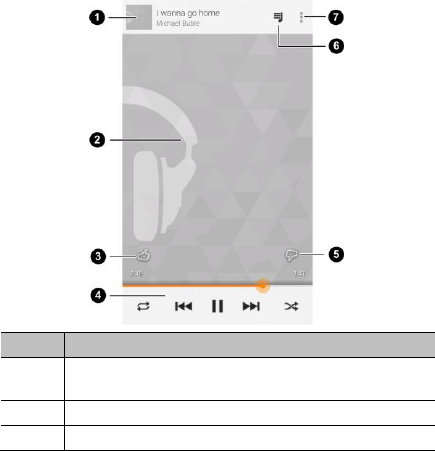
80
Touch a song to play it. When the song is playing, touch the
summary information at the bottom to display the playback
screen.
Number
Function
1
Song and artist information. Touch or drag down to
return to the music library.
2
Album artwork.
3
Give the song a thumbs-up.

81
Number
Function
4
Playback control. Skip songs, pause and resume
playback, use shuffle or repeat. Drag the progress
bar to jump to any part of the song.
5
Give the song a thumbs-down.
6
Touch to see the current playlist (queue).
7
Get more options.
You can still control the music when you are not in the
playback screen.
In the music library of the Play Music app, touch the
summary information at the bottom of the screen to
restore the playback screen.
In other apps, flick down the notification panel. Touch the
song title to restore the playback screen, or just pause/
resume playback, or skip to the next/previous song.
When the screen is locked, the song information, album
cover as well as playback control is displayed on the top
of the screen. You can pause/resume playback or skip
songs.
82
Sorting out Your Phone Settings
Setting Date and Time
1. Touch the Home Key > Menu Key > System settings >
Date & time.
2. Clear the Automatic date & time and Automatic time
zone check box if you want to set the time, date and time
zone by yourself.
3. Set date, time, time zone, and date/time format.
Changing Display Settings
By touching the Home Key > Menu Key > System
settings > Display, you can adjust the display settings as
you like.
Brightness: Set the brightness of the display.
Wallpaper: Select a background image for the home
screen and lock screen.
Sleep: Set the length of time of inactivity before the
screen turns off.
Font size: Set the font size of the text on the screen.
Pulse notification light: Flash the LED light to notify you
of missed calls, new messages, and other events.
83
Sound Settings
Touch the Home Key > Menu Key > System settings >
Sound to adjust volumes, toggle sound and mute, set up
ringtone and notification sound, and select system sounds.
Touch Silent mode to turn off all sounds except media and
alarm, or enable silent mode with vibration.
Language Settings
You can change the language of your phone system in two
simple steps.
1. Touch the Home Key > Menu Key > System settings >
Language & input > Language.
2. Touch a language from the list given.
Mobile Network Services
Touch the Home Key > Menu Key > System settings >
Mobile networks to enable or disable data service, allow
data services when roaming, select preferred network or
operator, or set access point names for data access.
IMPORTANT: Data roaming and always-on data may incur
significant roaming charges.
Security Settings
Protect your phone and micro-SIM card from unauthorized
use.

84
Protecting Your Phone With a Screen Unlock
Pattern
You can protect your phone by creating a screen lock. When
enabled, you need to “long press” an icon, draw a pattern, or
enter a numeric PIN or password to unlock the phone’s
screen and keys.
1. Touch the Home Key > Menu Key > System settings >
Security.
2. Touch Screen lock.
3. Touch Long press, Pattern, PIN or Password.
If you touch Long press, you must touch and hold
at the center of the screen to unlock the screen.
If you touch Pattern, you’re guided to create a pattern
you must draw to unlock the screen. The first time you
do this, a short tutorial about creating an unlock
pattern appears. Then you’re prompted to draw and
redraw your own pattern.
If you touch PIN or Password, you’re prompted to set
a numeric PIN or a password you must enter to unlock
your screen.
The next time you turn on your phone or wake up the screen,
you must draw your unlock pattern or enter your PIN or
password to unlock it.
IMPORTANT: If you forget the pattern you set, try five times
and touch Forget pattern? to sign in to the Google Account
85
you have added on the phone and reset the screen lock. You
need an active Internet connection. You can also upgrade
the phone software. See Upgrading the Phone Software.
Protecting Your Phone With Encryption
You can encrypt all the data on your phone: Google
Accounts, application data, music and other media,
downloaded information, and so on. If you do, you must enter
a numeric PIN or password each time you power on your
phone.
WARNING! Encryption is irreversible. The only way to revert
to an unencrypted phone is to perform a factory data reset,
which erases all your data.
Encryption provides additional protection in case your phone
is stolen, and may be required or recommended in some
organizations. Consult your system administrator before
turning it on. In many cases the PIN or password you set for
encryption is controlled by the system administrator.
Before turning on encryption, prepare as follows:
Set a lock screen PIN or password.
Charge the battery.
Keep the phone connected to the charger.
Schedule an hour or more for the encryption process: you
must not interrupt it or you will lose some or all of your
data.
86
When you're ready to turn on encryption:
1. Touch the Home Key > Menu Key > System settings >
Security > Encrypt phone.
2. Read the information about encryption carefully.
The Encrypt phone button is dimmed if your battery's not
charged or your phone's not plugged in.
If you change your mind about encrypting your phone,
touch the Back Key.
WARNING! If you interrupt the encryption process, you
will lose data.
3. Touch Encrypt phone.
4. Enter your lock screen PIN or password and touch Next.
5. Touch Encrypt phone again.
The encryption process starts and displays its progress.
Encryption can take an hour or more, during which time your
phone may restart several times.
When encryption is completed, you're prompted to enter your
PIN or password.
Subsequently, you must enter your PIN or password each
time you power on your phone, to decrypt it.
Protecting Your micro-SIM Card With a PIN
Every micro-SIM card comes with a PIN. The initial PIN is
provided by your mobile phone carrier. It’s best to lock your
micro-SIM card as soon as you can.
87
1. Touch the Home Key > Menu Key > System settings >
Security > Set up SIM/RUIM card lock.
2. Check Lock SIM card.
3. Enter the PIN you’ve been given and touch OK.
Changing Your SIM PIN
You can change the PIN you’ve been given to one easier for
you to remember and harder for others to guess.
1. Touch the Home Key > Menu Key > System settings >
Security > Set up SIM/RUIM card lock.
2. Make sure you already check Lock SIM card.
3. Touch Change SIM PIN.
4. Enter the old PIN and touch OK.
5. Enter your new PIN and touch OK.
6. Enter the new PIN again and touch OK.
Restoring a Locked micro-SIM Card
Put all your confidential passwords in a safe place for future
use. If you enter the wrong SIM PIN more times than allowed,
your micro-SIM card will be locked and you cannot access
the mobile phone network. Contact your operator for a PIN
Unlock Key (PUK) to restore the micro-SIM card.
Setting Up Credential Storage
This lets you select applications to access secure certificates
and other credentials.
88
Enabling Secure Credentials
1. Touch the Home Key > Menu Key > System settings >
Security.
2. Touch Install from SD card to install certificates from
your microSDHC card.
Deleting Secure Credentials
1. Touch the Home Key > Menu Key > System settings >
Security.
2. Touch Clear credentials to clear credentials.
Managing Your Device Memory
Touch the Home Key > Menu Key > System settings >
Storage. You can view the space information of the
microSDHC card as well as the phone storage.
Unmount/Mount SD card: You can unmount the
microSDHC card to safely remove it, or mount the card.
Erase SD card: Erase all data on the microSDHC card.
Privacy: Reset to Factory Settings
Touch the Home Key > Menu Key > System settings >
Backup & reset > Factory data reset > Reset phone >
Erase everything.
WARNING! All your personal information and downloaded
applications on your phone will be erased after the resetting.

89
Managing Applications
Touch the Home Key > Menu Key > System settings >
Apps to see apps installed on your phone and manage them.
Touch an app in the DOWNLOADED, ON SD CARD,
RUNNING, or ALL tab to see its information. You can stop
the app, uninstall the app, clear data and cache, or move the
app between the internal storage and the microSDHC card.
NOTE: Not all applications can be moved or uninstalled.
Touch the Home Key > Menu Key > System settings >
Security and check Unknown sources if you want to install
applications from sources other than the Google Play Store.
Note that you may compromise your phone and personal
data by installing such applications.
How to Install an Application
You can install a free or paid application from the Play Store
(the Home Key > > Play Store).
You can also install an application from sources other than
the Play Store if you have allowed the installation of it. To
allow the installation, touch the Home Key > Menu Key >
System settings > Security and clear the Unknown
sources check box and accept the warning.
Make sure that you select an application developed for your
phone and processor type before installing it.
1. You can copy the application file to the microSDHC card

90
and install the card on your phone.
2. Touch the Home Key > > File Manager, and open
the folder where the application file is.
3. Touch the file to start installation.
4. Read the installation instructions that come with the
application and follow it to complete the setup.
Managing Other Settings
Data Usage
Touch the Home Key > Menu Key > System settings >
Data usage. Touch the ON/OFF switch to turn on or off
mobile data.
You can check how much data has been used during the
time cycle you set, set a mobile data limit and warning, see
what apps have been using mobile data, or restrict
background data for individual apps.
Connect to PC
Touch the Home Key > Menu Key > System settings >
Connect to PC to select the USB connection mode between
your phone and PC.
Charge only: Charge your phone via USB.
USB mass storage: Transfer files between PC and the
microSDHC card on your phone.
91
NOTE: After selecting USB mass storage, you need to
open the notification panel and touch USB connected >
Turn on USB storage to turn on the USB mass storage
mode.
Install driver: Install the driver needed for some USB
connection modes (such as MTP). You only need to
install the driver on the same PC once.
NOTE: You can also install the driver on PC by running
the executable file in the new CD-ROM drive.
Media device (MTP): Transfer media files on Windows or
Mac.
NOTE: For Windows XP, please install the drivers and
Media Player 11(or later version) when you use Media
device (MTP) for the first time.
Camera (PTP): Transfer photos using camera software.
TIP: To make your phone connect to the computer
automatically using the selected connection type, check
Don’t ask me again.
Accessibility
Configure accessibility plug-ins on your phone, such as using
TalkBack for low-vision users.
Developer Options
Developer options contains settings that are useful when
developing Android applications.
92
About Phone
View phone status and legal information. You can also
upgrade your phone software.

93
Other Applications
Clock
Touch the Home Key > > Clock to use a series of timing
tools.
Set a New Alarm
1. Touch the Alarm tab in the Clock app.
2. Touch an existing alarm to configure it, or touch Add
alarm at the bottom of the screen to create a new alarm.
3. Set up the alarm options, such as time, repeat, and alarm
sound.
4. Touch SAVE to save and exit.
NOTE: To enable or disable existing alarms directly, just
touch or .
Use Bed Clock
You can use the phone as a bedside clock.
1. Touch the Alarm tab in the Clock app.
2. If necessary, touch the Menu Key > Bed Clock
Preferences to set up the following bed clock options.
Then touch the Back Key to return to the Alarm tab.
Enable bed clock: Turn on or off the bed clock
function.

94
Bed clock never sleeps: Keep the bed clock screen
turned on when charging the phone.
3. Touch the Menu Key > Bed Clock to open the bed clock
screen.
Check World Time
Touch the World time tab in the Clock app to check local
time for cities around the world.
Touch at the bottom to add a new city or country.
Use the Stopwatch and Countdown
Touch the Stopwatch or Countdown tab in the Clock app to
use the stopwatch or the countdown timer.
Stopwatch allows you to record lap times, while Countdown
allows you to set a time and count down to zero.
Calculator
Touch in the home screen and select Calculator.
TIP: Touch or , or swipe left or right to switch
between different panels. You can also hold the phone on its
side to see all of the calculator buttons.
Chrome
Use Google Chrome to browse the Internet. Chrome on your
phone can sync bookmarks, browsing history, and opened

95
tabs from your Google account.
Downloads
The Downloads app keeps a record of the files you
downloaded and saved.
Touch in the home screen and select Downloads to
check the record.
Touch a file to open it with the appropriate applications.
Touch and hold a file, or check the box in front of it, to
delete or share it.
File Manager
Quickly access all of your images, videos, audio clips, and
other types of files on your phone and on the microSDHC
card.
Touch in the home screen and select File Manager.
Touch the folder name at the top of the screen to switch
between the external microSDHC card storage and the
internal phone storage.
News and Weather
News & Weather offers weather forecasts and news stories
about common topics. You can also customize the news
topics that are displayed.

96
Touch in the home screen and select News & Weather.
Swipe left or right to view the weather forecast and news
headlines under different news topics.
Touch to refresh news and forecast data, or touch the
Menu Key > Settings to change the settings.
Task Manager
Touch in the home screen and select Task Manager to
view or stop applications.
Touch a task in the Tasks tab to see app information.
Touch next to a task to close it.
Touch the Apps tab to manage all the apps on your phone.
Touch the Resources tab to view the real-time system
resources information.
YouTube
Touch in the home screen and select YouTube.
You can watch YouTube videos or upload your own.
97
Upgrading the Phone Software
There are several ways to upgrade your phone software:
1. Use the online upgrade tool for mobile terminal products.
2. Use the one-press upgrade package offered by your mobile
service provider.
3. Use the upgrade package on your microSDHC card.
NOTE: Visit ZTE official handset service support website
(http://www.ztedevice.com/support/) and click your country or
region to learn more about the above upgrade methods, as well
as which phones and methods are supported.

98
Troubleshooting
If you encounter problems while using the phone, or if it performs
abnormally, you can refer to the chart below. If your particular
problem cannot be resolved using the information in the chart,
contact the dealer where you purchased the phone.
Problem
Possible causes
Possible solution
Poor
reception
The network signal is too
weak at your current
location, for example, in
a basement or near a
tall building, because
wireless transmissions
cannot effectively reach
it.
Move to a location
where the network
signal can be properly
received.
The network is busy at
the current time (for
example, during peak
times, there may be too
much network traffic to
handle additional calls).
Avoid using the phone
at such times, or try
again after waiting a
short time.
You are too far away
from a base station for
your service provider.
You can request a
service area map from
your service provider.

99
Problem
Possible causes
Possible solution
Echo or
noise
Poor network link quality
on the part of your
service provider.
End the call and dial
again. You may be
switched to a
better-quality network
link or phone line.
Poor local telephone line
quality.
End the call and dial
again. You may be
switched to a
better-quality network
link or phone line.
Unable to
select
certain
features
Your service provider
does not support these
features, or you have not
applied for services that
provide these features.
Contact your service
provider.
Battery not
charging
The battery or battery
charger is damaged.
Contact the dealer.
The phone’s
temperature is below
0°C or higher than 45 °C.
Adjust the battery
charging environment to
avoid extremes of
temperature.
Poor contact between
the battery and charger.
Check all connectors to
make sure all
connections have been
properly made.

100
Problem
Possible causes
Possible solution
Shortened
standby time
The standby time is
related to your service
provider system
configuration. The same
phone used with
different service
providers’ systems will
not provide exactly the
same length of standby
time.
If you are located in an
area where signaling is
weak, temporarily power
off the phone.
The battery is depleted. In
high temperature
environments, battery
life will be shortened.
Use a new battery.
If you are not able to
connect to the network,
the phone will continue
to send out signals as it
attempts to locate a
base station. Doing so
consumes battery power
and will consequently
shorten standby time.
Change your location to
one where the network
is accessible, or
temporarily turn off your
phone.

101
Problem
Possible causes
Possible solution
Cannot turn
your phone
on
Battery power has been
depleted.
Recharge the phone’s
battery.
micro-SIM
card error
micro-SIM card
malfunction or damage.
Take the micro-SIM card
to your service provider
for testing.
micro-SIM card inserted
improperly.
Insert the micro-SIM
card properly.
Debris on the micro-SIM
card contacts.
Use a soft, dry cloth to
clean the micro-SIM
card contacts.
Unable to
connect to
the network
micro-SIM card invalid.
Contact your service
provider.
You are not within the
network’s service area.
Check the service area
with your service
provider.
Poor signal.
Move to an open space,
or if you are inside a
building, move closer to
a window.
Cannot
answer
incoming
calls
You have activated the
Call barring feature.
Go to Call Barring
Settings, and then
select Deactive All.

102
Problem
Possible causes
Possible solution
You cannot
make
outgoing
calls.
You have activated the
Call barring feature.
Go to Call Barring
Settings, and then
select Deactive All.
You have activated the
Fixed dial numbers
feature.
Go to Fixed Dialing
Numbers and disable it.
PIN Code
blocked
You have entered an
incorrect PIN code three
consecutive times.
Contact your service
provider. If the service
provider provides the
micro-SIM card’s PUK
code, use the PUK code
to unlock the micro-SIM
card.
Unable to
enter
information
into the
phonebook
The phonebook’s
memory is already full.
Delete unnecessary
data from the contacts.
Phone
crashes,
reboots,
freeze, or
cannot be
Some third-party
software is not
compatible with your
phone.
Uninstall the software
that may cause the
problem.
Upgrade the phone
software.

103
Problem
Possible causes
Possible solution
powered on
Reset the phone to
factory status.
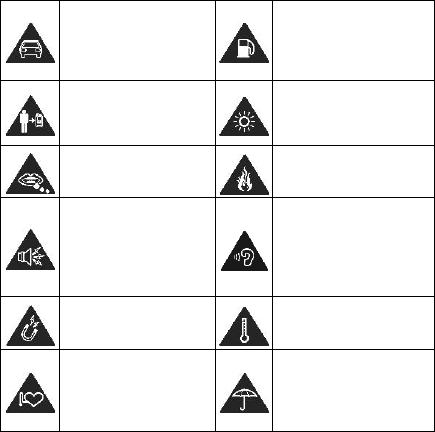
104
For Your Safety
General Safety
Don’t make or receive
handheld calls while
driving. Never text
while driving.
Don’t use at gas
stations.
For body-worn
operation maintain a
separation of 15 mm.
Your phone may
produce a bright or
flashing light.
Small parts may
cause choking.
Don’t dispose of your
phone in fire.
Your phone can
produce a loud sound.
To prevent possible
hearing damage, do
not listen at high
volume levels for long
periods.
Avoid contact with
anything magnetic.
Avoid extreme
temperatures.
Keep away from
pacemakers and other
electronic medical
devices.
Avoid contact with
liquids. Keep your
phone dry.

105
Turn off when asked
to in hospitals and
medical facilities.
Do not attempt to
disassemble your
phone.
Turn off when told to
in aircrafts and
airports.
Only use approved
accessories.
Turn off when near
explosive materials or
liquids.
Don’t rely on your
phone as a primary
device for emergency
communications.
Radio Frequency (RF) Energy
This device meets the government’s requirements for
exposure to radio waves.
This device is designed and manufactured not to exceed the
emission limits for exposure to radio frequency (RF) energy
set by the Federal Communications Commission of the U.S.
Government:
The exposure standard for wireless mobile devices employs
a unit of measurement known as the Specific Absorption
Rate, or SAR. The SAR limit set by the FCC is 1.6 W/kg.
Tests for SAR are conducted using standard operating
positions accepted by the FCC with the device transmitting at
its highest certified power level in all tested frequency bands.
Although the SAR is determined at the highest certified
106
power level, the actual SAR level of the device while
operating can be well below the maximum value. This is
because the device is designed to operate at multiple power
levels so as to use only the poser required to reach the
network. In general, the closer you are to a wireless base
station antenna, the lower the power output.
The highest SAR value for the device as reported to the FCC
when tested for use at the ear is 1.07 W/kg and when worn
on the body, as described in this user guide, is 1.01 W/kg
(Body-worn measurements differ among device models,
depending upon available enhancements and FCC
requirements.)
While there may be differences between the SAR levels of
various devices and at various positions, they all meet the
government requirement.
The FCC has granted an Equipment Authorization for this
device with all reported SAR levels evaluated as in
compliance with the FCC RF exposure guidelines. SAR
information on this device is on file with the FCC and can be
found under the Display Grant section of
http://www.fcc.gov/oet/ea/fccid/ after searching on:
FCC ID: SRQ-Z777
For body worn operation, this device has been tested and
meets the FCC RF exposure guidelines for use with an
accessory that contains no metal and the positions the
handset a minimum of 1.0 cm from the body. Use of other
enhancements may not ensure compliance with FCC RF
107
exposure guidelines. If you do not use a body-worn
accessory and are not holding the device at the ear, position
the handset a minimum of 1.0 cm from your body when the
device is switched on.
FCC Compliance
This device complies with part 15 of the FCC Rules.
Operation is subject to the following two conditions: (1) This
device may not cause harmful interference, and (2) this
device must accept any interference received, including
interference that may cause undesired operation.
CAUTION: Changes or modifications not expressly approved
by the manufacturer could void the user’s authority to
operate the equipment.
NOTE: This equipment has been tested and found to comply
with the limits for a Class B digital device, pursuant to part 15
of the FCC Rules.
These limits are designed to provide reasonable protection
against harmful interference in a residential installation. This
equipment generates, uses and can radiate radio frequency
energy and, if not installed and used in accordance with the
instructions, may cause harmful interference to radio
communications. However, there is no guarantee that
interference will not occur in a particular installation. If this
equipment does cause harmful interference to radio or
television reception, which can be determined by turning the
108
equipment off and on, the user is encouraged to try to correct
the interference by one or more of the following measures:
Reorient or relocate the receiving antenna.
Increase the separation between the equipment and
receiver.
Connect the equipment into an outlet on a circuit different
from that to which the receiver is connected.
Consult the dealer or an experienced radio/TV technician
for help.
Hearing Aid Compatibility (HAC)
regulations for Mobile phones
Your Z777 is compliant with the FCC Hearing Aid
Compatibility (HAC) requirements.
In 2003, the FCC adopted rules to make digital wireless
telephones compatible with hearing aids and cochlear implants.
Although analog wireless phones do not usually cause
interference with hearing aids or cochlear implants, digital
wireless phones sometimes do because of electromagnetic
energy emitted by the phone's antenna, backlight, or other
components. Your phone is compliant with FCC HAC
regulations (ANSI C63.19- 2011). While some wireless phones
are used near some hearing devices (hearing aids and
cochlear implants), users may detect a buzzing, humming, or
whining noise. Some hearing devices are more immune than
others to this interference noise and phones also vary in the
109
amount of interference they generate. The wireless telephone
industry has developed a rating system for wireless phones to
assist hearing device users in finding phones that may be
compatible with their hearing devices. Not all phones have
been rated. Phones that are rated have the rating on their box
or a label located on the box. The ratings are not guarantees.
Results will vary depending on the user's hearing device and
hearing loss. If your hearing device happens to be vulnerable
to interference, you may not be able to use a rated phone
successfully. Trying out the phone with your hearing device is
the best way to evaluate it for your personal needs.
This phone has been tested and rated for use with hearing
aids for some of the wireless technologies that it uses.
However, there may be some newer wireless technologies
used in this phone that have not been tested yet for use with
hearing aids. It is important to try the different features of this
phone thoroughly and in different locations, using your hearing
aid or cochlear implant, to determine if you hear any interfering
noise. Consult your service provider or the manufacturer of this
phone for information on hearing aid compatibility. If you have
questions about return or exchange policies, consult your
service provider or phone retailer.
M-Ratings: Phones rated M3 or M4 meet FCC requirements
and are likely to generate less interference to hearing devices
than phones that are not labeled. M4 is the better/higher of the
two ratings.
110
T-Ratings: Phones rated T3 or T4 meet FCC requirements and
are likely to be more usable with a hearing device’s telecoil (“T
Switch” or “Telephone Switch”) than unrated phones. T4 is the
better/ higher of the two ratings. (Note that not all hearing
devices have telecoils in them.)
Your phone meets the M3/T3 level rating.
Hearing devices may also be rated. Your hearing device
manufacturer or hearing health professional may help you find
this rating. For more information about FCC Hearing Aid
Compatibility, please go to http://www.fcc.gov/cgb/dro.
Distraction
Driving
Full attention must be given to driving at all times in order to
reduce the risk of an accident. Using a phone while driving
(even with a hands free kit) can cause distraction and lead to
an accident. You must comply with local laws and
regulations restricting the use of wireless devices while
driving.
Operating Machinery
Full attention must be given to operating the machinery in
order to reduce the risk of an accident.
111
Product Handling
General Statement on Handling and Use
You alone are responsible for how you use your phone and
any consequences of its use.
You must always switch off your phone wherever the use of a
phone is prohibited. Use of your phone is subject to safety
measures designed to protect users and their environment.
Always treat your phone and its accessories with care
and keep it in a clean and dust-free place.
Keep the screen and camera lens clean. Unclean screen
or camera lens may slow down the phone's reaction to
your operations or lower image quality.
Clean your phone and its accessories with a soft material
such as cleaning cloth for eyeglass lenses. Do not use
alcohol or other corrosive substances for cleaning or
allow them to get inside.
Do not expose your phone or its accessories to open
flames or lit tobacco products.
Do not expose your phone or its accessories to liquid,
moisture or high humidity.
Do not drop, throw or try to bend your phone or its
accessories.
Do not use harsh chemicals, cleaning solvents, or
aerosols to clean the device or its accessories.
112
Do not paint your phone or its accessories.
Do not attempt to disassemble your phone or its
accessories, only authorized personnel can do so.
Do not expose your phone or its accessories to extreme
temperatures, minimum 23 ℉ and maximum 122 ℉
(minimum – 5 ℃ and maximum + 50 ℃).
Do not place your phone inside or near heating
equipments or high pressure containers, such as water
heaters, microwave ovens, or hot cooking utensils.
Otherwise, your phone may be damaged.
Please check local regulations for disposal of electronic
products.
Do not carry your phone in your back pocket as it could
break when you sit down.
Battery
Do not disassemble or open crush, bend or deform,
puncture or shred.
Do not modify or remanufacture, attempt to insert foreign
objects into the battery, immerse or expose to water or
other liquids, expose to fire, explosion or other hazard.
Only use the battery for the system for which it is
specified.
Only use the battery with a charging system that has
been qualified with the system per CTIA Certification
113
Requirements for Battery System Compliance to IEEE
1725. Use of an unqualified battery or charger may
present a risk of fire, explosion, leakage, or other hazard.
Do not short circuit a battery or allow metallic conductive
objects to contact battery terminals.
Replace the battery only with another battery that has
been qualified with the system per this standard,
IEEE-Std-1725. Use of an unqualified battery may
present a risk of fire, explosion, leakage or other hazard.
Promptly dispose of used batteries in accordance with
local regulations.
Battery usage by children should be supervised.
Avoid dropping the phone or battery. If the phone or
battery is dropped, especially on a hard surface, and the
user suspects damage, take it to a service center for
inspection.
Improper battery use may result in a fire, explosion or
other hazard.
The phone shall only be connected to products that bear
the USB-IF logo or have completed the USB-IF
compliance program.
Small Children
Do not leave your phone and its accessories within the reach
of small children or allow them to play with it.
114
They could hurt themselves or others, or could accidentally
damage the phone.
Your phone contains small parts with sharp edges that may
cause an injury or may become detached and create a
choking hazard.
Demagnetization
To avoid the risk of demagnetization, do not allow electronic
devices or magnetic media close to your phone for a long
time.
Electrostatic Discharge (ESD)
Do not touch the micro-SIM card’s metal connectors.
Antenna
Do not touch the antenna unnecessarily.
Normal Use Position
When placing or receiving a phone call, hold your phone to
your ear, with the bottom towards your mouth.
Air Bags
Do not place a phone in the area over an air bag or in the air
bag deployment area as an airbag inflates with great force
and serious injury could result.
Store the phone safely before driving your vehicle.
115
Seizures/Blackouts
The phone can produce a bright or flashing light. A small
percentage of people may be susceptible to blackouts or
seizures (even if they have never had one before) when
exposed to flashing lights or light patterns such as when
playing games or watching video. If you have experienced
seizures or blackouts or have a family history of such
occurrences, please consult a physician. To reduce the risk
of blackouts or seizures, you can use your phone in a well lit
room and take frequent breaks.
Repetitive Strain Injuries
To minimize the risk of Repetitive Strain Injury (RSI) when
texting or playing games with your phone:
Do not grip the phone too tightly.
Press the buttons lightly.
Use the special features which are designed to minimize
the times of pressing buttons, such as Message
Templates and Predictive Text.
Take lots of breaks to stretch and relax.
Emergency Calls
This phone, like any wireless phone, operates using radio
signals, which cannot guarantee connection in all conditions.
Therefore, you must never rely solely on any wireless phone
for emergency communications.
116
Loud Noise
This phone is capable of producing loud noises, which may
damage your hearing. Turn down the volume before using
headphones, Bluetooth stereo headsets or other audio
devices.
Phone Heating
Your phone may become warm during charging and during
normal use.
Electrical Safety
Accessories
Use only approved accessories.
Do not connect with incompatible products or accessories.
Take care not to touch or allow metal objects, such as coins
or key rings, to contact or short-circuit in the battery
terminals.
Never puncture the surface of the battery with sharp objects.
Connection to a Car
Seek professional advice when connecting a phone interface
to the vehicle electrical system.
117
Faulty and Damaged Products
Do not attempt to disassemble the phone or its accessory.
Only qualified personnel can service or repair the phone or
its accessory.
If your phone or its accessory has been submerged in water,
punctured, or subjected to a severe fall, do not use it until
you have taken it to be checked at an authorized service
center.
Radio Frequency Interference
General Statement on Interference
Care must be taken when using the phone in close
proximity to personal medical devices, such as pacemakers
and hearing aids.
Please consult your doctor and the device manufacturer to
determine if operation of your phone may interfere with the
operation of your medical device.
Pacemakers
Pacemaker manufacturers recommend that a minimum
separation of 15 cm be maintained between a mobile phone
and a pacemaker to avoid potential interference with the
pacemaker. To achieve this, use the phone on the opposite
ear to your pacemaker and do not carry it in a breast pocket.
118
Hearing Aids
People with hearing aids or other cochlear implants may
experience interfering noises when using wireless devices or
when one is nearby.
The level of interference will depend on the type of hearing
device and the distance from the interference source,
increasing the separation between them may reduce the
interference. You may also consult your hearing aid
manufacturer to discuss alternatives.
Medical Equipment
Switch off your wireless device when requested to do so in
hospitals, clinics or health care facilities. These requests are
designed to prevent possible interference with sensitive
medical equipment.
Aircraft
Switch off your wireless device whenever you are instructed
to do so by airport or airline staff.
Consult the airline staff about the use of wireless devices on
board the aircraft and enable the airplane mode of your
phone when boarding an aircraft.
Interference in Vehicles
Please note that because of possible interference to
electronic equipment, some vehicle manufacturers forbid
119
the use of mobile phones in their vehicles unless a
hands-free kit with an external antenna is included in the
installation.
Explosive Environments
Gas Stations and Explosive Atmospheres
In locations with potentially explosive atmospheres, obey all
posted signs to turn off wireless devices such as your phone
or other radio equipment.
Areas with potentially explosive atmospheres include fuelling
areas, below decks on boats, fuel or chemical transfer or
storage facilities, areas where the air contains chemicals or
particles, such as grain, dust, or metal powders.
Blasting Caps and Areas
Power off your mobile phone or wireless device when in a
blasting area or in areas posted power off “two-way radios”
or “electronic devices” to avoid interfering with blasting
operations.